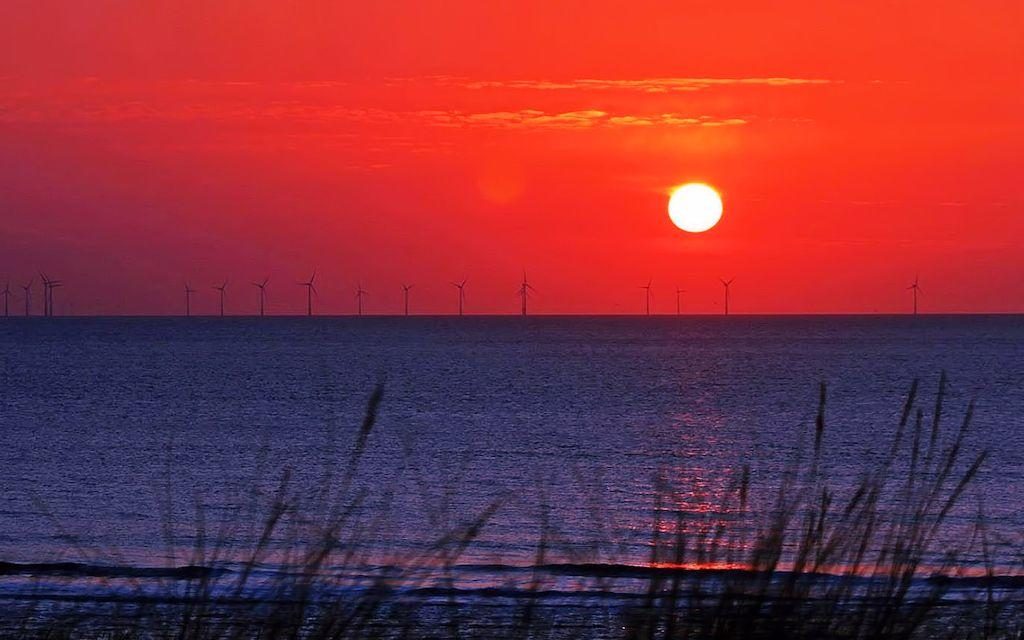The Egmond aan Zee wind farm is the first large wind farm to be built in the North Sea off the Dutch coast. The park consists of 36 wind turbines, each with a capacity of 3 MW. Together, they provide renewable electricity for more than 100,000 households. This is comparable to a municipality like Eindhoven.
 King Willem Alexander (then crown prince)
King Willem Alexander (then crown prince)
Operates first Dutch wind farm in North Sea
Fourteen school children from Egmond aan Zee together with H.R.H. the Prince of Orange today officially commissioned the first Dutch wind farm on the North Sea. With a combined effort, they literally blew on the windmills, putting the cleanest power plant in the Netherlands into operation.
So far, the performance of the wind farm – which has been technically operational since the beginning of this year – has been excellent. Thanks in part to turbulent weather in the first quarter with high winds, more than 111 million kilowatt-hours of electricity were produced. That is the annual power consumption of more than 33,000 households.
The park site is 10 to 18 kilometers off the coast near Egmond aan Zee. The total area of the park covers some 27 km2 . In clear weather, the park will be visible from the beach.
Building this offshore wind farm will contribute to making the energy supply more sustainable. In doing so, the knowledge and experience gained from this project will be used in the future development of wind energy as a renewable energy source. The Ministry of Economy has also clearly named the park as a demonstration project.
This underscores the social importance of making energy supplies more sustainable. After all, the demand for energy is still increasing and it is becoming increasingly clear that it is necessary to bring in new sources. It’s just that we can’t determine with certainty now which sources will be in the future. Wind energy is attractive because it is widely available and can, in principle, be developed offshore on a large scale. Key success factors here include the extent to which the wind farm can be built and maintained safely and how the costs of new projects can be reduced.
The project involves an investment of more than €200 million. The Dutch government is supporting the project in three different ways: through the Environmental Quality Electricity Production (MEP) scheme and an investment subsidy under the Ministry of Economic Affairs’ CO2 reduction plan. Finally, the fiscal Energy Investment Allowance (EIA) scheme applies.
Origins History In 2001, the government launched a tender process. To this, Shell and Nuon jointly submitted their plans under the name NoordzeeWind. In spring 2002, NoordzeeWind was selected as the winning party and in July of that year, NoordzeeWind signed the concession agreement with the government for the realization of the park. In subsequent years, the park continued to be developed. This involved acquiring the necessary permits and working on soil surveys and wind measurements. At the end of May 2005, Shell and Nuon signed the final contracts to jointly realize the Egmond aan Zee offshore wind farm
 Government
Government
The Dutch government wants to make energy supplies more sustainable. It aims to contribute 10% renewable energy of total energy demand by 2020. In this regard, onshore and offshore wind power is an important form of renewable energy generation. The Egmond aan Zee offshore wind farm is a first step for offshore wind energy. From the government side, there is also an explicit intention to use the knowledge and experience from this project in future development
Of wind power as a renewable energy source. To this end, an extensive research program is being conducted by NoordzeeWind. This research was partially funded by the Ministry of Economy.
Construction
NoordzeeWind subcontracted the construction of the Egmond aan Zee Offshore Wind Farm (OWEZ) to Bouwcombinatie Egmond (BCE) a collaboration between Ballast Nedam and Danish wind turbine builder Vestas.
BCE has developed an innovative method for installing the wind turbines. The lifting vessel the Svanen is being used to install the steel foundation piles of the mills. Then, using a crane ship, the masts of the mills and wind turbines will be installed.
The new IJmond port of IJmuiden, which is in open communication with the sea, will be the logistics base. Here all components are collected and transported to the offshore location. Component assembly and quality control also take place here.
Electricity
The Egmond aan Zee offshore wind farm will be commissioned at the end of 2006. On an annual basis, the park provides enough energy to supply electricity to over 100,000 households. This is sufficient for all households in a city like Eindhoven.
The park is pre-designed to produce electricity for 20 years. After 20 years, the park will be demolished.
